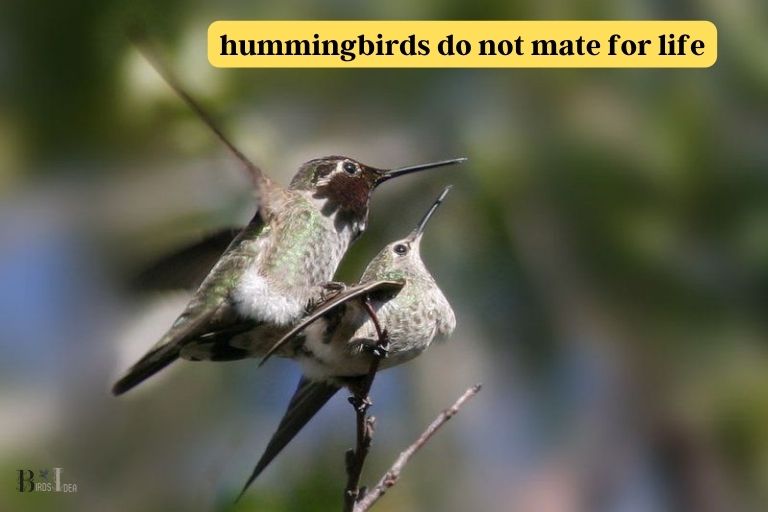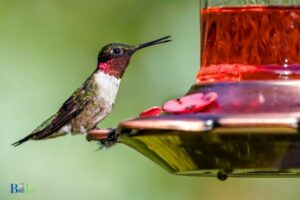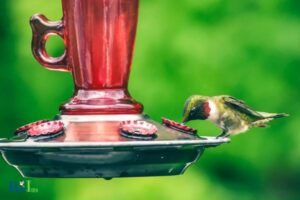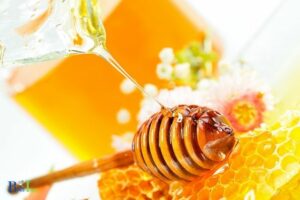Do Hummingbirds Mate for Life: NO, 6 Aspects!
No, hummingbirds do not mate for life.
Hummingbirds are solitary by nature. They do not form long-term bonds or relationships.
During the mating season, the male hummingbird’s sole focus is on attracting a female.
After mating, the female hummingbird carries out all the responsibilities of building the nest, incubating the eggs, and feeding the hatchlings, while the male moves on to mate with other females.
Instead, males take multiple female mates and defend larger territories against competing males.
Hummingbirds form no permanent relationships, but males may form leks where they show off bright feathers and vocalization to the mate of their choice.
This behavior often commences the mating process, which involves a rushed courtship and a fast in-flight copulation.
After this phase is completed, the female is often alone in the nest-building and egg-laying process.
6 Aspects Hummingbirds Mate for Life
| Aspect | Information |
| Pair Bonding | Hummingbirds do not bond for life. |
| Courting Period | Males perform a diving display to attract females. |
| Post-mating | After mating, males and females separate. |
| Parenting | Only female hummingbirds take part in nesting and rearing the young. |
| Lifespan | Hummingbirds typically live for 3-5 years. |
| Multiple Mates | Both male and female hummingbirds may have multiple mates in a single breeding season. |
Key Takeaway

Five Facts About: Hummingbirds Mate for Life
DID YOU KNOW
There are more than 325 species of hummingbirds in the world.
Why Do Hummingbirds Not Mate For Life?
Hummingbirds don’t typically form long-term relationships or mate for life like some other species of birds do.
To understand why this is, it’s important to first take a look at the lifestyle of hummingbirds and their mating habits.

Hummingbirds typically have short lifespans, usually only surviving for about three to five years in the wild.
This means that a pair of hummingbirds that mated the previous year may not be together for the next breeding season.
Additionally, hummingbirds tend to be solitary creatures, and the males often migrate alone.
These two factors mean that hummingbirds are often unable to form the kind of long-term relationships that are seen in other bird species.
Another factor that affects hummingbird mating habits is their diet. While other birds may feed their young together as a pair, hummingbirds must visit many different flowers to gather enough nectar to feed themselves and their young.
This means that they often lack the opportunity to bond in the same way that other bird species do.
Finally, hummingbirds also tend to have multiple mates throughout the breeding season, meaning that forming a monogamous bond with a single mate is not advantageous for them.
In conclusion, hummingbirds do not typically mate for life due to their relatively short lifespans, solitary lifestyles, varied diet, and mating habits.
What Is Promiscuity In Hummingbirds?
Promiscuity in hummingbirds refers to the mating behavior of certain species of hummingbirds, where males mate with multiple females.
This mating strategy is common in the family Trochilidae, which includes most hummingbird species.

In promiscuous hummingbirds, males typically do not form strong pair-bonds with individual females, instead they will mate with multiple females during the breeding season.
This behavior is beneficial for the males as it increases their chances of passing on their genes to the next generation.
Males also benefit from this behavior because they don’t have to invest in caring for offspring, as the females are the ones that build the nests and incubate the eggs.
Females, on the other hand, benefit from mating with multiple males as it increases the likelihood that the genes of her offspring will be diverse and of a high quality.
While promiscuous mating behaviors are common in hummingbirds, certain species such as the Anna’s Hummingbird, practice monogamous mating.
This means that males form strong pair-bonds with a single female and will only mate with her during the breeding season.
Overall, promiscuity in hummingbirds is a common mating behavior that is beneficial for both males and females.
It increases the chances of successful reproduction and allows for increased gene diversity among the offspring.
Do Male Hummingbirds Defend Territories?
Yes, male hummingbirds do defend territories. This is especially important in the breeding season when food is scarce and they need to protect a good food source.
To defend their territories, male hummingbirds will make loud vocalizations, chase other birds away, and perform dives and U-shaped flights to make themselves appear larger and intimidate other birds.

The territorial behavior of male hummingbirds helps them to attract mates, find food, and protect their nests from predators. This behavior is especially evident in species that feed on nectar from flowers.
Male hummingbirds will chase away other birds, including other hummingbirds, from their territories to monopolize a good food source. The territories of the males can range in size from a few feet up to several acres.
The territorial behavior of male hummingbirds also serves to protect their nests from predators. By defending their territories, male hummingbirds help ensure their survival, as well as the survival of their young.
In conclusion, male hummingbirds do indeed defend territories. This behavior helps them to attract mates, find food, and protect their nests from predators, ensuring their survival and the survival of their young.
Are There Any Preferrred Mate Relationships For Hummingbirds?

Yes, there are several preferred mate relationships for hummingbirds. These vary depending on the species of hummingbird, but they generally include monogamous and polygynous relationships.
Monogamous relationships involve two hummingbirds forming a pair bond and mating with each other exclusively. This is common in species such as the Broad-tailed Hummingbird and the Costa’s Hummingbird.
Polygynous relationships involve one male mating with multiple females. This is more common in species such as the Allen’s Hummingbird and the Anna’s Hummingbird.
In some species, such as the Black-chinned Hummingbird, both monogamous and polygynous relationships may occur.
Overall, the preferred mate relationships for hummingbirds are determined by the species and the environment that they live in.
For example, male hummingbirds may choose to pursue a polygynous relationship if there is sufficient food availability in their environment.
What Are Leks In Hummingbirds?
Leks are areas where male hummingbirds compete to attract female mates.
During lekking, male hummingbirds will display their feathers and dance in the air to competitively attract female hummingbirds.
The female hummingbirds will then select the most desirable mate from the lek.

Leks are typically found near open areas such as fields, meadows, and clearings, and are known to attract multiple species of hummingbirds. The males are often highly territorial and will vigorously defend their courtship areas.
Examples of hummingbirds that use leks include the rufous hummingbird, the Anna’s hummingbird, and the black-chinned hummingbird.
What Is the Mating Process For Hummingbirds?

Hummingbirds typically mate in the air, a process called a “flight display.” The male hummer will perform a dive from a high altitude and make a loud vocalization as he dives, as a way to attract the female.
Once the female is attracted, the male will then fly around the female in tight circles, fluttering his wings and making more loud vocalizations. It’s thought that these vocalizations serve to show off the male’s strength and stamina.
Once the female signals her acceptance of the male, they will fly together in a tight embrace and lock bills, forming a heart shape in the air. The two will then separate and the female will choose a nesting site.
The male will continue to provide protection and food for the female until the eggs hatch.
Does The Female Hummingbird Receive Help During The Nest-Building and Egg-Laying Process?
No, female hummingbirds do not receive help during the nest-building and egg-laying process.
Building and laying eggs is the sole responsibility of the female hummingbird.
The female hummingbird starts the nest-building and egg-laying process by selecting an appropriate site, such as a bush or tree.

She then builds the nest, which is usually made of moss, plant fibers, lichen, and spider webs.
After the nest is built, the female hummingbird will lay two eggs. The female hummingbird is then solely responsible for incubating the eggs and feeding and caring for the chicks once they have hatched.
To illustrate, a female ruby-throated hummingbird was observed building a nest, laying two eggs, incubating the eggs, and feeding the young once they hatched, all without any help from her mate.
This demonstrates that the female hummingbird does not receive help during the nest-building and egg-laying process.
“It’s always the males’ obligations to find the mate, but it’s usually the females who undertake the most work.”
– Scott Thomson
FAQ of Do Hummingbirds Mate For Life
Do hummingbirds mate for life?
How long does a hummingbird mating pair last?
Do hummingbird couples stay together forever?
Are hummingbirds socially monogamous?
Do hummingbirds sustain their relationships after breeding?
Conclusion
While hummingbirds are beautiful and fascinating creatures, they do not mate for life.
Instead, they use more promiscuous behavior, such as defending larger territories against competing males and forming leks for mating.
Despite this, females still remain largely responsible for nest-building and egg-laying.






